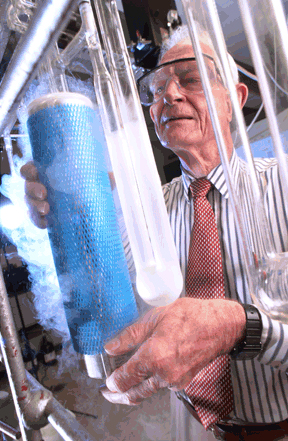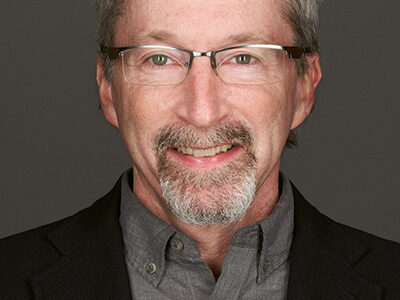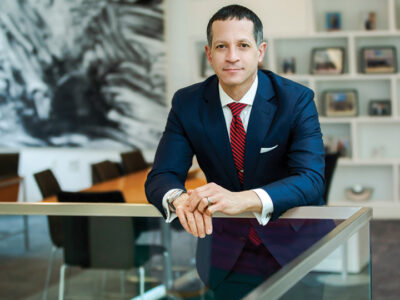
Well over a half-century and one Nobel Prize later, Penn Professor Alan G. MacDiarmid still possesses—and communicates to students—the energy and enthusiasm of a 10-year old with his first chemistry book.
By Joan P. Capuzzi Giresi | Photography by Jim Graham
Most people on an airplane sink into their seats, and then into their books. Or work. Or idle conversation. Most people do not spend a lot of time looking out the window, and if they do they’re generally not thinking about much of anything (unless they happen to be nervous fliers). But Dr. Alan G. MacDiarmid—Blanchard Professor of Chemistry at Penn, “father” of conducting polymers, 2000 Nobel laureate—is not most people. Every time MacDiarmid travels by air, he gazes into the hinterlands of 30,000 feet above-sea-level. For years he has been trying to figure out how those fluffy cumulus clouds can appear to have sharply-defined edges if they’re made up of free-floating vapor.
Now in his eighth decade, long after most of us have learned all we ever will (or want to), MacDiarmid is still a little boy full of questions, his youthful mind a great, insatiable sponge. He delights in being stumped by an offbeat query from one of his chemistry students, and then searching for the answer. He keeps a notebook by his bed to record the nocturnal inspirations that race from his vigorous psyche. He teaches himself Mandarin Chinese and cell biology, both for the sake of his research.
Dr. William Salaneck, professor of surface physics and chemistry at Linköping University in Sweden, who nominated MacDiarmid for the 2000 Nobel Prize in Chemistry, cites his “tremendous chemical intuition” to explain how MacDiarmid personifies the unique spirit Alfred Nobel called for in his last will and testament in setting up the prize to recognize those who have “bestowed the greatest benefit on mankind.”
MacDiarmid’s former graduate student Dr. Xun Tang, now a project leader at Rohm and Haas Company in Spring House, Pennsylvania, says, “He asks questions others wouldn’t ask. He pays attention to phenomena that others would have slept through.” Like billowy clouds during airplane rides. And silvery glop that most people would summarily discard.

The Great Discovery began over a cup of green tea in Tokyo, in the mid-1970s. MacDiarmid and his host, Dr. Hideki Shirakawa, a polymer chemist, talked about a silly lab error: A Korean graduate student in Shirakawa’s lab, hindered by language barriers, mistakenly used 1,000 times the requisite amount of catalyst for a chemical reaction. The result was a jelly-like plastic that shone like metal. As mistakes go, the story should have ended there.
But chance favors the prepared mind, and MacDiarmid was prepared. He coaxed his Japanese colleague into spending a year at Penn to help him study this unique material. Along with a third researcher, Dr. Alan Heeger, then a professor of physics at Penn, they would discover a unique class of plastics that conduct electricity—which would eventually win them worldwide recognition in the chemistry Nobel.
In a brilliant interdisciplinary collaboration, the three researchers enhanced the conductivity of that first shimmery polymer, polyacetylene, by spiking it with the highly conductive element, bromine. They then worked around the clock to develop similar polymers of even greater conductivity. “We were very excited because we were getting observations that no one else had previously attained,” MacDiarmid says. “But we were very doubtful about whether we were correct or not.” The researchers gained more confidence in their results once others began to duplicate their data.
With the birth of the field of conducting polymers, an international floodgate of research in the chemistry and physics of these novel plastics swung open. Twenty-or-so conducting polymers have since been developed throughout the world, and they have been used in cell-phone and pager displays, transistors, light-emitting diodes, and lightweight electromagnetic shields. Now in development are virtual-reality displays and electroluminescent wallpaper—which can provide power-saving illumination for occupants, who will be able to manipulate the paper colors and patterns at will—that use conducting-polymer technology. Penn holds some 20 patents on conducting polymers.
At the time MacDiarmid and his two colleagues carried out the meat of their work on conducting polymers, there were no laptops, cell phones, or other immediate applications for their new technology. “Conducting polymers were an answer waiting for the pertinent question, which had not yet been asked,” he says.
For MacDiarmid, the pleasure was derived from the journey—the intellectual pursuit of answers—more than the destination, but he points to a general moral regarding the practicality of scientific investigations. “So often when I give a lecture people say, ‘That’s very interesting, but how can we use it?,’ to which I reply, ‘Of what use is a beautiful poem?’”
Certainly, there is something almost poetic in MacDiarmid’s hard-line science. In a lecture on science and creativity presented last December at the Einstein Forum in Potsdam, Germany, MacDiarmid discussed the limitations of conventional wisdom. Twenty-five years ago, he explained, plastics were considered strictly electrical insulators. His revolutionary research, however, bucked this long-held notion. Because MacDiarmid, Heeger, and Shirakawa yielded to real-life observations rather than to theory, plastics having high electrical conductivity—“conducting polymers,” “electronic polymers” or “synthetic metals”—are now well known.
“What is at the edge of scientific or social acceptability today is often commonplace tomorrow,” he says. “Whether something is good or bad, hot or cold, black or white, there’s so much in the eye of the beholder. The greatest limitation on social progress is the mind.”
For example, “We were always told that the inert gases—those with eight electrons in their outer shell—cannot form chemical compounds. Eventually one of these, xenon, was found to be reactive,” he continues. “Then people throughout the world started reporting the production of xenon compounds. And all those years, people had accepted [the alternative] as fact. But finally, people’s minds were released to produce new compounds.”
MacDiarmid tells his students and research assistants to question everything, verbal or written, and it’s a rule he lives by as well. Dr. Page McAndrew, senior research scientist at Atofina Chemicals, Inc. in King of Prussia, Pennsylvania, worked in MacDiarmid’s lab for four years in the early 1980s. He can still hear the oft-repeated words of his Ph.D. adviser: “MacDiarmid used to say, ‘Theories come and theories go, but the facts go on forever. So you have to get the facts correct.’”
MacDiarmid is a man of many mottoes, and sprinkles his conversation with those that inspire him the most—some borrowed, some his own: “The harder I work, the luckier I seem to be.” “When you stop learning, you start dying.” “Be very slow to say that others are wrong—no matter how strongly you think you are correct.” And, perhaps his favorite, “We all stand on the shoulders of giants,” a humbling saying that, he says, pays homage to “the work of other people in other years, other centuries.”
Quotes help MacDiarmid to reinforce his convictions, he says, and that is why he likes them. Perhaps his strongest conviction is the power of persistence. Before embarking on his research on conducting polymers, MacDiarmid had had a thriving career in the field of silicon chemistry for two decades. When McAndrew came to work with him in 1980, he was impressed by his optimistic, indefatigable approach to challenges. “He made sure that for every observation we made, we were going to get some good out of it.” When they tried to produce a battery using conducting polymers, the initial results were not what they had hoped for, McAndrew remembers. “But he said, ‘Theoretically, it should give us x, y, and z.’ So he kept changing the design until he got x, y, and z.” It was a process that took many months, says McAndrew, “a time scale in which a lot of people would have just bagged it.”
MacDiarmid credits his persistence to growing up poor, which, he says, made him self-reliant. Born in Masterton, New Zealand, in 1927, MacDiarmid remembers well the Great Depression, which hit the country hard during the 1930s. His father, an engineer, became unemployed during this time. During grade school, MacDiarmid had an early-morning job delivering milk by bicycle for a local farmer. The family had no telephone or refrigerator, they rationed their food, and Alan and his four older siblings rotated through the same bath water during their weekly bath night. From his close-knit clan, he learned interpersonal skills that would serve him in his professional life.
He would help his older brother to make printing paper and mix developer chemicals for his darkroom at home. He remembers the awe and curiosity he had for this “magical” process whereby a photographic image appears on a previously blank sheet of paper. When he was about 10 years old, his interest in chemistry became crystallized when he found one of his father’s old chemistry text books. “I spent hours poring over the pages in complete confusion, but with burning curiosity!” he recalls. The turning point came when he found a children’s book called The Boy Chemist at his local library. Elated that he finally had a chemistry book he could understand, MacDiarmid renewed the book continually for over a year, carrying out most of the experiments in it.
On MacDiarmid’s curriculum vitae, what stands out most is not the 600-plus published scientific papers he has co-authored or his many awards, honorary degrees, and memberships on editorial boards of international journals, but his first chemistry job—as a “lab boy” in the chemistry department at Victoria University of Wellington. He still lists the position, which he began at the age of 16, because, he says, “I feel it’s important to show that I was a part-time student all the way through.”
Still, MacDiarmid doesn’t focus on his plebeian past. “People always say to me, ‘You have truly achieved, given where you came from.’ But I was brought up in New Zealand doing a lot of mountaineering. When you do mountaineering, you don’t ever look behind you at where you came from. You look at the mountains ahead of you.”
In 1948, MacDiarmid became the only one of his siblings to graduate from college, with a B.Sc. from Victoria University. He was then awarded a Fulbright fellowship, which he used to earn a Ph.D. in inorganic chemistry from the University of Wisconsin. There, he met his future wife, Marian, with whom he had four children. After using a New Zealand Shell graduate scholarship to study silicon hydrides at the University of Cambridge and earn a doctorate in organic chemistry, he accepted a junior position in the Department of Chemistry at Penn in 1955, and has been here ever since.
When MacDiarmid was awarded the Nobel Prize in 2000, he became the first Penn professor to receive this distinction in 20 years, and Penn’s only chemistry professor to do so. [Several chemistry alumni, however, are Nobelists, with whom MacDiarmid shares a recently established exhibit in the Chemistry Building, described on page 15—Ed.] The work that won the prize was completed in three labs at Penn by the three co-winners. Of this fact, Penn’s provost, Dr. Robert Barchi Gr’72 M’72, is especially proud: “We want to underscore the interdisciplinary nature of this accomplishment. The work they have done has cut across traditional disciplinary boundaries.”
MACDIARMID’S CRAMPED THIRD-FLOOR OFFICEin the Chemistry Building at 34th and Spruce streets is cluttered with Asian knick-knacks, boomerangs, and a few scummy bowls of magnetic fish that clink around in odd harmony. Chemistry texts spill from every wall. MacDiarmid tries to sit down and talk, but is unable to stay in one spot for more than a few minutes. He springs from his chair to hunt down a piece of nicotine gum (he quit a one-and-a-half-pack-a-day habit three years ago). He springs from his chair to rummage through presentation materials. He springs from his chair to look for a picture. Joke with his secretary. Greet a passerby … He peppers his dialogue with the Kiwi phrase Jolly good! His energy level belies his years. His lean physique attests to his lifelong love of outdoor activities such as water-skiing, which he enjoys at his vacation home on Lake Wallenpaupack in the Poconos.
In between preparing coffee and looking for things amid the clutter, MacDiarmid affirms his belief that research and teaching go hand-in-hand. It is a conviction that he acts on personally—for example, he is currently teaching freshman general chemistry for the first time in years. He says he extended the offer as a way of showing his gratitude to Penn for supporting his research, which is principally funded by the U.S. Office of Naval Research and the National Science Foundation, all these years. But the benefit is clearly mutual. “I enjoy the interaction with inquiring young minds,” he says, adding that last semester’s freshman seminar was, for him, the most enjoyable class he has taught in his 46 years at Penn.
He recalls a lecture last fall in which he was talking about the attractive forces that conjoin positive sodium and negative chloride ions to form NaCl, or table salt. A student raised his hand and, noting that positive and negative charges can also repel each other, asked why the salt crystals don’t explode. “I had paraphrased this process over and over again through the years,” MacDiarmid says, a chiseled grin widening across his congenial face, “and no one had ever questioned it. But now I had to go home and think about the answer. At the next class, I explained that the crystal structure that forms is the most stable. So the crystal form exists because the overall net attractive forces are stronger than the overall net repulsive forces. But the student’s question stimulated me to reexamine things.”
Dr. Hai-Lung Dai, chairman of the Department of Chemistry, adds that MacDiarmid’s freshman lecture will likely encourage more students to embark on science careers shortly after matriculating at Penn. Dai notes that the number of foreign Ph.D. applicants to Penn’s chemistry program has tripled since MacDiarmid’s Nobel was announced.
Barchi feels that Penn’s student body has a tremendous resource in MacDiarmid. “I am so impressed with him as a person, how warm he is, how committed he is to the education of his students and his junior colleagues,” he says.
His former students fondly remember their days with MacDiarmid, who taught them to be critical thinkers. “He would not challenge you directly,” recalls Tang, who earned his Ph.D. under MacDiarmid’s tutelage in 1991, “but he would ask you to challenge your own conclusion by asking you to look at a problem from different angles.”
McAndrew says that MacDiarmid read every word of his dissertation, a rare occurrence among Ph.D. advisers. “He is obsessed with doing things the right way,” he adds. “He would always make sure I was doing the right thing and writing down correctly what I observed. He would say, ‘If you write it up or present it in a sloppy manner, no one will believe it.’”
In industry, McAndrew has succeeded in the challenging pursuit of technology transfer from laboratory to store shelf. He credits his days with MacDiarmid for the wisdom that enabled him to prosper. “He taught me less about chemistry than you’d think, and more about life than you’d think.”
MACDIARMID WINCES WHEN he speaks of the fanfare surrounding the Nobel. He was at his Drexel Hill home preparing an exam when the phone rang. While downplaying the declaration (“It interfered with all the work I had to do that day”), he remembers the phone call with the precision with which one remembers the birth of a baby: “It was 9:33 a.m. on Tuesday, October 10, when I got the call at my home from Professor Joel Miller of the chemistry department at the University of Utah.” Miller, a friend, had just read the news online.
“I thought it must be a hoax,” recalls MacDiarmid, who wasn’t expecting the award. Although there had been buzz about it in the last few years, the possibility was so remote as to eliminate it from his radar screen entirely. Furthermore, the work had been completed two decades earlier. But this lengthy time lag between research finding and Nobel recognition is normal, Sweden’s Salaneck explains. “The discovery they made in the late seventies led to an enormous amount of chemistry in the eighties, which led to the involvement of industry in the 1990s. It was then that we realized how important this discovery was.”
The $915,000 award from the Royal Swedish Academy of Sciences was split by the three recipients—MacDiarmid, Shirakawa, and Heeger. Unfazed by the money (“Money has never been of any importance to me whatsoever. I’ve never driven anything flashier than a Toyota”), MacDiarmid used his share to fly 22 of his relatives to Stockholm for the awards ceremony and to build college funds for his nine grandchildren.
Life for MacDiarmid has changed since the award. He has become a celebrity in his homeland, where he has been inducted into the Order of New Zealand, the highest honor now bestowed by that country. His guest-lecture invitations have doubled, and audience members tend to treat him differently. “They often ask questions designed to stump the Nobel Prize winner, or show that the Nobel Prize winner has made a mistake in his lecture,” he says with a chuckle that suggests that he sort of enjoys playing along with the game. He is somewhat amused that his Nobel Prize has accorded him omniscience in the eyes of many, who now seem to expect him to be an expert on everything under the sun. “If one is asked about ancient Egyptology, for example, one is expected to give a very erudite answer,” he says.
Because of the increased weight that his opinions now carry, and their unintended migration into the newspapers, MacDiarmid selects his words more carefully than in the past, and often declines to take public positions on controversial issues. He recently refused to sign a petition on gene cloning because he felt that his opinion on the issue was merely a knee-jerk response. “If one cannot give all the arguments for a case and all of the arguments against a case, then one should not be comfortable in believing the arguments that one proposes,” he says.
EVER THE DISCIPLINED AND LOGICAL THINKER, MacDiarmid found himself completely unprepared for his greater sense of urgency since winning the Nobel Prize. “When my colleagues in the past received the Nobel Prize, I always thought, ‘Now you can relax for the rest of your professional life.’ But I found this was completely the opposite. Because one always hears of the older person at the conference who everyone points at and says, ‘He used to be a really great chemist.’ And now I think, ‘Will they say that about MacDiarmid?’ So getting the prize actually puts one’s feet to the fire. Now that I’ve won the prize, I’m expected to come out with glittering work.”
And so, in the pursuit of such, MacDiarmid arises around 5:30 each morning and starts working at home, usually correcting student papers or handling written correspondence. Shortly after eight, he heads into Penn, where he lectures and discusses research projects with his students and research assistants. He goes home after seven in the evening for a late dinner with his “life partner,” retired school teacher Gayl Gentile (his wife, Marian, died in 1990). The two usually end the night with a cocktail and a dip in their outdoor hot tub.
MacDiarmid has spent his lifetime in different learning phases. At 50, he taught himself solid-state physics in order to enter the field of conducting polymers. Now, at 75, he is schooling himself in cell biology in order to transport white blood cells through the air by zapping them with 25,000 volts of electricity. For this, he is collaborating with the Rena Rowan Cancer Research Center at the Hospital of the University of Pennsylvania. But his primary research interest is the burgeoning field of nanoscience, which utilizes electronic organic polymers to produce conducting polymer nanofibers (diameter <100 nm). He will have an international scope of influence in this field through his leadership roles in three institutes—The NanoTech Institute of the University of Texas at Dallas; the Jilin MacDiarmid Institute of organic nanomaterials at Jilin University in Changchun, China; and the MacDiarmid Institute of Materials Science and Nanotechnology at Victoria University of Wellington, New Zealand, his alma mater.
While banking on five to 10 years of progressive research ahead of him, MacDiarmid is curious to see whether, once all the Nobel hoopla has died down, the international research community will show interest in the work he has done after winning the prize.
MacDiarmid wishes he were still young, because there are so many phenomena he wants to explore. “It’s just that your whole psyche gets wound up and keen,” he says. He will probably continue to gaze out of airplane windows until he finds an answer to his troubling question about cloud vapor … but always with an ear to the ground, in search of the next generation of research to pursue.
Joan P. Capuzzi Giresi C’86 V’98 last wrote for the Gazette about the Wistar Institute in March/April 2001.




